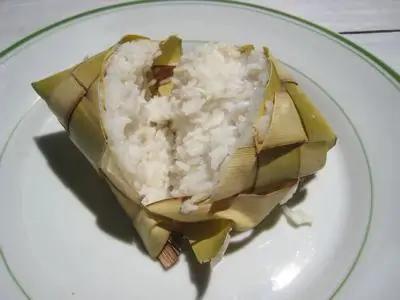2025 Author: Isabella Gilson | [email protected]. Last modified: 2025-01-23 12:50:30
Chocolate is valued mainly for its wonderful taste and smell. But also because it improves mood, adds energy, relieves fatigue. The chemical composition of chocolate includes not just sugar, fat and unnecessary calories, but also minerals, a certain amount of vitamins and other biochemically active compounds such as theobromine, flavonoids, caffeine and phenyl-thylamine. Consider the nutritional value and beneficial properties of this product.
History

Chocolate comes from South America. Cocoa grows there, also called the cocoa tree (lat. Theobroma cacao), from which cocoa powder and butter are obtained. They are the main ingredients of chocolate. Around 2000 BC, a powder made from cocoa beans was used by the ancient Olmecs living in what is now Mexico. The warm and humid climate prevailing in this area was ideal forgrowing a cocoa tree. However, it will always be a secret how they discovered the benefits of small grains and learned how to use them.
The true cult of chocolate was developed by the Maya in the 3rd century AD. They roasted and ground cocoa beans. The resulting powder was mixed with water, cornmeal, honey and chili. Thus, a bitter and highly spicy drink was created, which was originally intended mainly for kings, aristocrats and participants in religious ceremonies. Chocolate was a very revered product and performed extremely important functions during the celebration of sacred rituals.
From the Maya, the Aztecs adopted the custom of eating chocolate. They introduced many innovations in this area. The Aztecs preferred a cool drink enriched with flavors of paprika, vanilla, or dried flower petals, which gave it its color: red, white, or black. Cocoa beans were so valuable that they served as a payment coin.
The first European to taste cocoa was Christopher Columbus. The fruits he brought to Europe did not immediately arouse interest. A drink from them first gained recognition in the Spanish court. In other countries, attempts have been made to brew a similar mixture from the increasingly common cocoa bean. However, it was too bitter. The Spaniards for a hundred years hid the secret method of making it with vanilla and sugar. Only in the 17th century was the hot drink introduced to other countries.
For many years it has been used in aristocratic homes. The breakthrough came in the 17th century, whenchocolate candies. In the 18th century, the chocolate industry developed in many European countries. Switzerland stood out in particular, and to this day is one of the largest chocolate producers in the world.

In 1879, Swiss confectioner Rudolf Lindt invented a device that mixes chocolate ingredients so that the tart aroma disappears, and the mass acquires a velvety texture and can melt in the mouth. In Switzerland, Henry Nestlé contributed to the development of milk chocolate by adding condensed milk to a bitter mass of cocoa. Thanks to this invention, Daniel Peter created the famous and widely loved milk chocolate today. Raisins, nuts were added by the Italians as an addition to the sweet treat.
Useful properties

Chocolate has been used for hundreds of years as a cure for all diseases. The Aztecs were the first to discover that cocoa beans had powerful stimulant properties. It was believed that it is useful for digestive disorders, fever, and also affects the purification of the blood. It was beneficial for headaches and was even used to relieve the pain of childbirth.
Chocolate was also considered an effective aphrodisiac. Phenylthylamine present in the chemical composition of chocolate triggers the production of serotonin and endorphins in the brain. Serotonin counteracts depression and reduces susceptibility to disorders of the nervous system such as schizophrenia. Endorphins improve mood and increase feelings of pleasure. Chocolate also contains a largethe amount of magnesium (especially bitter). This element not only improves muscle function and promotes the absorption of calcium, but also, like serotonin, counteracts stress.
The chemical composition of chocolate contains caffeine and theobromine, so it can be addictive. The beneficial effects of the product will only be felt by people who consume it from time to time. Those who eat it very often become resistant to its effects, so not only do they not feel the benefits of magnesium and serotonin, but they can also suffer from migraines and headaches.
A side effect of excessive consumption of the product can also be overweight, in addition, people suffering from cardiovascular diseases and diabetes should avoid sweetened chocolate. It can cause an allergic reaction in the body - allergens can be cocoa, milk, wheat and nuts contained in it. Milk chocolate is also harmful for people who are lactose intolerant.
Types of chocolate

There are four main types of product:
- Bitter chocolate - the chemical composition of which consists of grated cocoa, cocoa butter and sugar, sometimes with a small admixture of vanilla and / or other flavoring. This species contains at least 70% cocoa. There is also chocolate with 95% (and even more) cocoa content. Due to the high content of the main ingredient and low sugar content, it is considered the most valuable type of product. The more cocoa and less sugar, the better.
- Dark chocolate - its chemical compositioncontains from 30 to 70% cocoa liquor, the rest is fat, sugar and additives.
- Milk chocolate - contains no more than 50% cocoa liquor, although most chocolates on the market contain only 20%, and a large amount of milk. The sugar content reaches 50%, so it is very sweet. Thanks to the milk additive, it has a mild and delicate taste. Sometimes, instead of cocoa butter, the chemical composition of milk chocolate is supplemented with vegetable fats and artificial flavors. It is this species that is in great demand by the buyer in the market.
- White chocolate - it does not contain grated cocoa, but contains a large amount of cocoa butter, sugar and milk (sometimes cream) and vanilla. The chemical composition of good quality white chocolate includes up to 33% cocoa fat. Some gourmets believe that this type is not chocolate due to its low cocoa content. Currently, a very large selection of chocolate products is presented on the food market. Nuts and other ingredients such as raisins, coffee, caramel, cappuccino, liquor are added to traditional chocolate bars. In addition, the product can be filled with fruits and jams from them. Aerated (bubble) chocolate, which is formed from the chocolate mass and then exposed to permitted inert gases, is very popular. There are chocolate-like products on the market where the cocoa content does not exceed 7% of the total weight.
Briefly about the chemical composition of different types of chocolate
Natural chocolate (bitter and dark) is rich in he althy substances. White and milk - at the expense ofcondensed milk supplements contain protein, which is a factor in cell growth and regeneration of the body, as well as calcium, which is important for muscle function and the proper functioning of the nervous system, enzymes and blood clotting.

Below is a table comparing the chemical composition of different types of chocolate. Values per 100g of product.
| Product type | Bitter | Milky | White |
| Calories (energy value) | 599 kcal / 2508 kJ | 535 kcal / 2240 kJ | 539 kcal / 2257 kJ |
| Protein | 7, 79g | 7, 65g | 5, 87g |
| Total Fat | 42, 63g | 29, 66g | 32, 09 |
| Saturated fatty acids | 24, 489g | 18, 50g | 19, 412g |
| Monounsaturated fatty acids | 12, 781g | 7, 186 g | 9, 097 g |
| Polyunsaturated fatty acids | 1, 257 g | 1, 376g | 1, 013 |
| Omega-3 fatty acids | 0.034 g | 0, 122 g | 0, 100g |
| Omega-6 fatty acids | 1, 212g | 1, 254g | 0.913g |
| Carbohydrates | 45, 90g | 59, 40g | 59, 24g |
| Dietary fiber | 10, 9g | 3, 4 g | 0, 2g |
| Vitamin A | 39 IU | 195 IU | 30 IU |
| Vitamin D | 0 mcg | 0 mcg | 0 mcg |
| Vitamin E | 0.59mg | 0.51mg | 0.96mg |
|
Vitamin K1 |
7, 3 mcg | 5, 7 mcg | 9, 1 mcg |
| Vitamin C | ~ | 0 mg | 0.5mg |
|
Vitamin B1 |
0.034mg | 0, 112mg | 0.063mg |
|
Vitamin B2 |
0.078mg | 0, 298mg | 0, 282mg |
|
Vitamin B3 (PP) |
1, 054mg | 0, 386mg | 0, 745mg |
|
Vitamin B6 |
0.038mg | 0.036mg | 0.056mg |
|
Vitamin B9 (folic acid) |
~ | 12 mcg | 7 mcg |
|
Vitamin B12 |
0, 28 mcg | 0.75 mcg | 0.56 mcg |
|
Vitamin B5 (pantothenic acid) |
0, 418mg | 0, 472mg | 0, 608mg |
| Calcium | 73mg | 189mg | 199 mg |
| Iron | 11, 9mg | 2, 35mg | 0, 24mg |
| Magnesium | 228mg | 63mg | 12mg |
| Phosphorus | 308mg | 208 mg | 176 mg |
| Potassium | 715 mg | 372mg | 286mg |
| Sodium | 20mg | 79mg | 90mg |
| Zinc | 3, 31mg | 2, 30 mg | 0.74mg |
| Copper | 1, 77mg | 0, 49mg | 0.06mg |
| Manganese | 1, 95mg | 0, 47mg | 0.01mg |
| Selenium | 6, 8 mcg | 4.5 mcg | 4.5 mcg |
| Fluorine | ~ | 5, 0 mcg | ~ |
| Cholesterol | 3mg | 23 mg | 21mg |
| Phytosterols | 129mg | 53mg | ~ |
What are chocolate-like products made from?
Chocolate-like product resembles chocolate in terms of appearance and taste. It is a cheaper and more affordable substitute for real chocolate. Produced due to the low cost of production. In chocolate-like products, the cocoa content does not exceed 7% of the total weight. Since they are cheaper than chocolate, they are very popular among consumers on a budget. These foods are, unfortunately, a rich source of trans fats, so dietitians advise avoiding them.
Fake type chocolate chemical composition: sugar, bad vegetable fat, whey powder, fat-free cocoa powder, skimmed milk powder, emulsifier (lecithin) and artificial flavor. The manufacturer must somehow get the resemblance to chocolate, and synthetic compounds arethe only solution if expensive cocoa is not used in production. It is worth knowing that chocolate-like products can often be found in cheap seasonal sweets - at Easter, Christmas and New Year.
Quality Criteria

Interesting criteria for the quality of chocolate were proposed by the British institution of the Academy of Chocolate. A good quality product contains only cocoa fat. Does not contain other vegetable fats. The second criterion is the percentage of cocoa. Bitter chocolate must contain at least 70% cocoa mass and at least 25% milk. The high-quality product does not contain preservatives, fragrances, dyes and other artificial additives. The origin, processing and quality of cocoa beans must be taken into account during production. It is worth choosing sweets that contain a small amount of trans fats, because they cause an increase in cholesterol levels and contribute to the development of atherosclerosis and diabetes. Filled chocolate, chocolate products (e.g. pralines, bars) and white chocolate contain the highest amounts of trans fats.
It's worth knowing
Perfect Chocolate:
- has a smooth, velvety texture without lumps;
- melts slowly in your mouth;
- breaking tiles into pieces is accompanied by a characteristic crack;
- it is devoid of bitter and sour aftertaste;
- the product has a nice shine without traces of white bloom;
- poorly reacts to changes in air temperature, that is, it should not melt even in the heat.
What does the white coating onchocolate?

White or gray coating on chocolate does not mean it has gone bad. These are microscopic particles of fat found in chocolate (not mold, as some believe). It results from storing sweets at different temperatures, such as when chocolate is dissolved and then placed in the refrigerator. This is not harmful to he alth, only spoils the aesthetic appearance of the product.
Now you know how the chemical composition and nutritional value of different types of chocolate differ.
Recommended:
Cod fish: benefits and harms, calories, composition of vitamins and minerals, nutritional value and chemical composition. How to cook delicious cod

This article will tell you about what is included in the chemical composition of cod, what benefits it brings to human he alth, and also in what cases it should not be consumed. There will also be presented several recipes for cooking cod in the oven, in a pan, in the form of fish soup, etc
Pumpkin: nutritional value, chemical composition, calorie content and beneficial properties

Pumpkin is a herbaceous plant from the Cucurbitaceae family. About 8 thousand years ago, pumpkins were first cultivated in South America. The vegetable came to Europe after several millennia thanks to navigators. The shape of the pumpkin varies from round to flattened ellipse. The color of this vegetable is also ambiguous, it can be either bright orange or dark green, depending on the variety, stripes on the fruits can also be observed
Cottage cheese for dinner: nutrition rules, calorie content, nutritional value, recipes, nutritional value, composition and useful properties of the product

How to get true gastronomic pleasure? Very simple! It is only necessary to pour a little cottage cheese with a jar of delicious fruit yogurt and enjoy every spoonful of this delicious delicacy. It's one thing if you ate this simple dairy dish for breakfast, but what if you decide to have cottage cheese for dinner? How will this affect your figure? This question is of interest to many who are trying to adhere to all the postulates of proper nutrition
Nutritional value of boiled brown rice. Rice: nutritional value per 100 gr

What is rice? Rice varieties with a brief description. Technology of cultivation and storage of crops. Nutritional value of rice in raw and boiled form. Harm and benefit to the human body
Meat: nutritional value, chemical composition, biological value, energy value, characteristic

Humanity has been eating meat since antiquity. Anthropologists believe that meat, whose nutritional value is invaluable, played a huge role in the development of the human brain

